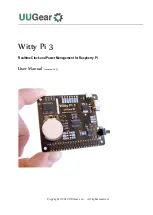
EN
G
LI
SH
10
KEY FUNCTIONS
The
✱
key
• While entering the access code, pressing the
✱
key cancels
the operation: The keypad is immediately ready for entering a
new code.
• During programming, pressing the
✱
key cancels all
operations and activates STAND-BY mode.
• In STAND-BY mode, it is used to identify the operational
mode of the device (see the following section)
The
#
key
This is used to activate programming mode and navigate through
the various programs.
The 0,1,2,3,4,5,6,7,8,9 keys
• During programming, these are used to select the menus and
set the various codes.
• During normal operation, they are used to enter access codes.
OPERATIONAL MODE
SIRMO-DIGIT can operate in 4 different modes, depending on the
system with which it is associated.
ROYAL
• compatibility with dip-switch transmitters transmitting a
ROYAL type code at 433.92 MHz
• 4 access codes available
• the access code set activates the radio transmission
• transmission lasts for 2 seconds, and is indicated by LEDs L1
and L2 coming on
• each access code corresponds to a different channel
53200
• compatibility with dip-switch transmitters transmitting a
12-bit 53200 type code at 433.92 MHz
• 4 access codes available
• the access code set activates the radio transmission
• transmission lasts for 2 seconds, and is indicated by LEDs L1
and L2 coming on
• each access code corresponds to a different channel
PERSONAL PASS
• compatibility with all rolling code transmitters transmitting a
PERSONEL PASS type code at 433.92 MHz
• 9 access codes available
• the access code set activates the radio transmission
• transmission lasts for 2 seconds, and is indicated by LEDs L1
and L2 coming on
• each access code corresponds to a different channel
PERSONAL PASS - MONOSTABLE (only for RADIO models)
• compatibility with all rolling code transmitters transmitting a
PERSONEL PASS type code at 433,92 / 868,3 MHz
• 9 access codes available
• the access code set enables radio transmission for 5 seconds,
which is activated by pressing keys
✱
and
#
• the two keys,
✱
and
#
, correspond to 2 remote control
channels (
✱
= key1 and
#
= key3) and always transmit the
same code, independently of the access code entered
• transmission lasts for the entire time key
✱
or
#
is pressed,
and is signalled by BEEPS
IDENTIFICATION OF THE OPERATIONAL
MODE
To identify the operational mode set, simply press the Q key and
count the number of flashes emitted by LEDs L1 and L2 (just LED
L1 in the cabled version):
-
1 flash:
ROYAL mode
-
2 flashes: 53200 mode
-
3 flashes: PERSONAL PASS mode
-
4 flashes: PERSONAL PASS mode with MONOSTABLE
operating logic
SIGNALS
The device signals events by means of two LEDs (Fig. 6) and a
buzzer.
The buzzer emits a “beep” each time the keys are pressed. On
entering the correct access code, the two LEDs, L1 and L2 are lit
and code transmission activated.
If configured in “PERSONAL PASS - monostable” mode, the two
LEDs remain on for 5 s while waiting for keys
✱
or
#
to be
pressed, activating transmission in MONOSTABLE mode.
In the cabled version, just LED L1 is lit to indicate transmission.
LED L2 indicates the status of the input N.C. (1) to which it is
possible to connect a sensor for indicating the status of the
entrance (OPEN/CLOSED).
All other signals relate to programming and are described below.
PROGRAMMING
The programming menu allows the modification of the following
parameters:
1. PROGRAMMING CODE
2. ACCESS CODE
3. WORKING MODE: ROYAL, 53200, PERSONAL PASS,
PERSONAL PASS - MONOSTABLE
4. DIP-SWITCH CODE (only version Royal/53200)
The keypad is normally in STAND-BY mode, i.e. awaiting
commands; the radio version has the back-light off in order to
save battery power, while in the cabled version, the back-light is
always on.
In programming mode, the keypad goes back to SLEEP mode in
the following cases:
• When pressing the key
✱
in any programming phase.
• When more than one minute pass between the pressure of
two consecutive keys.
• After the 3 second BEEP stating the correct execution of an
operation.
• In the case of an error during any of the programming steps:
the two LEDs flash briefly for 3 seconds, then the keypad
switches to STAND-BY mode without saving the new settings.
In any case, if you want to go on with programming it is
necessary to start again from the entering of the programming
code.
In the working mode the digital selector goes back to STAND-BY
mode after 5 seconds of inactivity.
Summary of Contents for SIRMO-DE
Page 2: ...Fig 2 Fig 1...
Page 3: ...Fig 3 Fig 4 Fig 5 Fig 7...
Page 33: ......
Page 34: ......
Page 35: ......
Page 36: ......











































